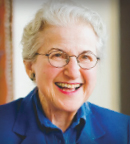The American Association for Cancer Research (AACR) issued the following statement regarding the passing of Beatrice Mintz, PhD, FAACR, a trailblazing pioneer in multiple fields of cancer biology, who died January 3, 2022, at the age of 100.
Born on January 24, 1921, in New York, New York, Dr. Mintz graduated magna cum laude from Hunter College and earned a master’s degree in 1944 and a doctorate in 1946 from the University of Iowa. Dr. Mintz received a Fulbright research fellowship at the Universities of Paris and Strasbourg in 1951.
Dr. Mintz was Professor of Biological Science at the University of Chicago from 1946 to 1960 and then transitioned to a faculty position at Fox Chase Cancer Center, where she remained for the rest of her career. Dr. Mintz held several different positions at Fox Chase, including the Jack Schultz Chair in Basic Science from 2002 to 2019. She also served as Adjunct Professor at the University of Pennsylvania.

Beatrice Mintz, PhD, FAACR
Distinguished Career and Lifetime Achievements
In 2012, Dr. Mintz received the AACR Award for Lifetime Achievement in Cancer Research, and in 2013, she was elected to the inaugural class of Fellows of the AACR Academy. Among other AACR activities, Dr. Mintz served as Associate Editor of Cancer Research from 1993 to 2000 and was a member of Women in Cancer Research from 2014 to 2021.
“Dr. Mintz was a brilliant scientist whose trailblazing work established clonal regulation as one of cancer’s fundamental units of development,” said Margaret Foti, PhD, MD (hc), Chief Executive Officer of the AACR. “She made foundational discoveries and revolutionized many tools and techniques of molecular biology that paved the way for tremendous progress in our understanding of cancer.”
During her distinguished career, Dr. Mintz made unprecedented discoveries in several different aspects of biology, including developmental genetics, gene-transfer technology, embryology, epigenetics, and the tumor microenvironment. She was the first to propose that chimeric mice could be constructed in a manner that would allow for two genetically distinct cell populations to coexist throughout life. In such animals, specific cell lineages became detectable, which led Dr. Mintz to ascertain that development involves an expanding succession of progressively restricted stem cells that are able to proliferate clonally and subsequently differentiate into desired cell types.
This led her to postulate that cancer represents an aberration of development in which proper cellular homeostasis is modified in favor of proliferation that may be further exacerbated by genetic insults. Dr. Mintz next demonstrated that transgenic mice could be engineered by modifying genes in utero, which allowed for mouse models of specific cancers to be purposely developed for future research.
Furthermore, Dr. Mintz demonstrated the importance of the local cellular environment in governing cellular behavior, especially stem cells. In a groundbreaking experiment, she showed that early carcinoma stem cells could be stably normalized if transferred to a normal cellular environment appropriate for their developmental stage. Her research findings and breakthroughs have since been leveraged by countless cancer researchers to establish specific mouse models of cancer. Her model of cutaneous melanoma, in particular, became a widely used research tool.
Accolades and Awards
Dr. Mintz was appointed to the President’s Biomedical Research Panel (Development Biology Group) in 1975. Among many other career awards, she was honored with the New York Academy of Sciences Award in Biological and Medical Sciences in 1979; the National Medal of Honor for Basic Research from the American Cancer Society in 1997; and the Pearl Meister Greengard Prize from Rockefeller University in 2008. She was the first recipient of several prestigious awards, including the Genetics Society of America Medal in 1981, the Ernst Jung Gold Medal for Medicine in 1990, and the March of Dimes Prize in Developmental Biology in 1996. She was a Fellow of the American Academy of Arts and Sciences and the American Association for the Advancement of Science and was an elected member of the National Academy of Sciences.

